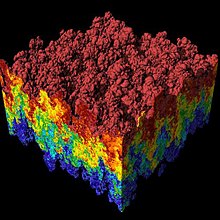| Computational physics |
|---|
 |
The Morse/Long-range potential (MLR potential) is an interatomic interaction model for the potential energy of a diatomic molecule. Due to the simplicity of the regular Morse potential (it only has three adjustable parameters), it is very limited in its applicability in modern spectroscopy. The MLR potential is a modern version of the Morse potential which has the correct theoretical long-range form of the potential naturally built into it.[1] It has been an important tool for spectroscopists to represent experimental data, verify measurements, and make predictions. It is useful for its extrapolation capability when data for certain regions of the potential are missing, its ability to predict energies with accuracy often better than the most sophisticated ab initio techniques, and its ability to determine precise empirical values for physical parameters such as the dissociation energy, equilibrium bond length, and long-range constants. Cases of particular note include:
- the c-state of dilithium (Li2): where the MLR potential was successfully able to bridge a gap of more than 5000 cm−1 in experimental data.[2] Two years later it was found that the MLR potential was able to successfully predict the energies in the middle of this gap, correctly within about 1 cm−1.[3] The accuracy of these predictions was much better than the most sophisticated ab initio techniques at the time.[4]
- the A-state of Li2: where Le Roy et al.[1] constructed an MLR potential which determined the C3 value for atomic lithium to a higher-precision than any previously measured atomic oscillator strength, by an order of magnitude.[5] This lithium oscillator strength is related to the radiative lifetime of atomic lithium and is used as a benchmark for atomic clocks and measurements of fundamental constants.
- the a-state of KLi: where the MLR was used to build an analytic global potential successfully despite there only being a small amount of levels observed near the top of the potential.[6]
- ^ a b Le Roy, Robert J.; N. S. Dattani; J. A. Coxon; A. J. Ross; Patrick Crozet; C. Linton (2009). "Accurate analytic potentials for Li2(X) and Li2(A) from 2 to 90 Angstroms, and the radiative lifetime of Li(2p)". Journal of Chemical Physics. 131 (20): 204309. Bibcode:2009JChPh.131t4309L. doi:10.1063/1.3264688. PMID 19947682.
- ^ Dattani, N. S.; R. J. Le Roy (8 May 2011). "A DPF data analysis yields accurate analytic potentials for Li2(a) and Li2(c) that incorporate 3-state mixing near the c-state asymptote". Journal of Molecular Spectroscopy. 268 (1–2): 199–210. arXiv:1101.1361. Bibcode:2011JMoSp.268..199D. doi:10.1016/j.jms.2011.03.030. S2CID 119266866.
- ^ Semczuk, M.; Li, X.; Gunton, W.; Haw, M.; Dattani, N. S.; Witz, J.; Mills, A. K.; Jones, D. J.; Madison, K. W. (2013). "High-resolution photoassociation spectroscopy of the 6Li2 13Σ+ state". Phys. Rev. A. 87 (5): 052505. arXiv:1309.6662. Bibcode:2013PhRvA..87e2505S. doi:10.1103/PhysRevA.87.052505. S2CID 119263860.
- ^ Halls, M. S.; H. B. Schlegal; M. J. DeWitt; G. F. W. Drake (18 May 2001). "Ab initio calculation of the a-state interaction potential and vibrational levels of 7Li2" (PDF). Chemical Physics Letters. 339 (5–6): 427–432. Bibcode:2001CPL...339..427H. doi:10.1016/s0009-2614(01)00403-1.
- ^ L-Y. Tang; Z-C. Yan; T-Y. Shi; J. Mitroy (30 November 2011). "Third-order perturbation theory for van der Waals interaction coefficients". Physical Review A. 84 (5): 052502. Bibcode:2011PhRvA..84e2502T. doi:10.1103/PhysRevA.84.052502.
- ^ Salami, H.; A. J. Ross; P. Crozet; W. Jastrzebski; P. Kowalczyk; R. J. Le Roy (2007). "A full analytic potential energy curve for the a3Σ+ state of KLi from a limited vibrational data set". Journal of Chemical Physics. 126 (19): 194313. Bibcode:2007JChPh.126s4313S. doi:10.1063/1.2734973. PMID 17523810.
© MMXXIII Rich X Search. We shall prevail. All rights reserved. Rich X Search
